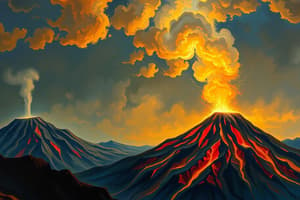Podcast
Questions and Answers
In 79 C.E., the citizens of Pompeii in the Roman Empire were buried by pyroclastic debris derived from an eruption of?
In 79 C.E., the citizens of Pompeii in the Roman Empire were buried by pyroclastic debris derived from an eruption of?
- Mt. Vesuvius (correct)
- Olympus Mons
- Mt. St. Helens
- Mt. Olympus
Basaltic lavas?
Basaltic lavas?
- Are less viscous than rhyolitic lavas (correct)
- Contain more silica than rhyolitic lavas
- Contain less iron and magnesium than rhyolitic lavas
- Contain a greater proportion of trapped volatiles than rhyolitic lavas
Basaltic lavas that solidify at the surface before flow ceases fracture irregularly, producing a sharp-surfaced lava rock named?
Basaltic lavas that solidify at the surface before flow ceases fracture irregularly, producing a sharp-surfaced lava rock named?
- Pahoehoe
- A'a' (correct)
- Pumice
- Hyaloclasite
Rhyolitic lavas?
Rhyolitic lavas?
Ash, lapilli, and bomb are all types of?
Ash, lapilli, and bomb are all types of?
A fast-moving flow consisting of a mixture of water and volcaniclastic debris is termed a?
A fast-moving flow consisting of a mixture of water and volcaniclastic debris is termed a?
Gases that are abundantly emitted by volcanoes include?
Gases that are abundantly emitted by volcanoes include?
Explosive or voluminous eruptions may cause the volcano to collapse on the floor of the (now empty) magma chamber, producing a broad depression termed a?
Explosive or voluminous eruptions may cause the volcano to collapse on the floor of the (now empty) magma chamber, producing a broad depression termed a?
Of the three primary forms of subaerial volcanoes, which are the most violent?
Of the three primary forms of subaerial volcanoes, which are the most violent?
Of the three primary forms of subaerial volcanoes, which have the most gently sloping sides due to the low viscosity of the basaltic lavas that form them?
Of the three primary forms of subaerial volcanoes, which have the most gently sloping sides due to the low viscosity of the basaltic lavas that form them?
Of the three primary forms of subaerial volcanoes, which consist of a simple, conical pile of tephra?
Of the three primary forms of subaerial volcanoes, which consist of a simple, conical pile of tephra?
Mt. Fuji in Japan is an example of a?
Mt. Fuji in Japan is an example of a?
To monitor magma activity in a volcanic area, geologists measure?
To monitor magma activity in a volcanic area, geologists measure?
Nonviolent eruptions characterized by extensive flows of basaltic lava are termed?
Nonviolent eruptions characterized by extensive flows of basaltic lava are termed?
As compared to subaerial basaltic lavas, submarine basaltic lavas differ in that they?
As compared to subaerial basaltic lavas, submarine basaltic lavas differ in that they?
At continental rifts, vast bodies of basaltic lava flow forth from fissures, forming?
At continental rifts, vast bodies of basaltic lava flow forth from fissures, forming?
One of the reasons volcanic eruptions are so deadly is that there is no way to predict where an eruption will occur in the near future.
One of the reasons volcanic eruptions are so deadly is that there is no way to predict where an eruption will occur in the near future.
Flashcards are hidden until you start studying
Study Notes
Volcanoes and Eruptions
- In 79 C.E., Mt. Vesuvius erupted, burying Pompeii under pyroclastic debris.
- Basaltic lavas are less viscous than rhyolitic lavas, allowing them to flow more easily.
- A'a' is a type of lava rock formed from basaltic lavas that fracture irregularly upon cooling.
- Rhyolitic lavas do not flow as far from the vent compared to basaltic lavas.
Pyroclastic Materials
- Ash, lapilli, and bombs are classified as types of pyroclastic debris.
- Lahars are rapid flows made of water and volcaniclastic debris, often resulting from heavy rains or melting snow on volcanoes.
Volcanic Gases
- Common volcanic gases include water vapor, carbon dioxide, and sulfur dioxide, significant for understanding volcanic activity.
Volcanic Structures
- A caldera forms when a volcano collapses into an empty magma chamber after an explosive eruption.
- Stratovolcanoes are known for their violent eruptions and steep sides.
- Shield volcanoes have gently sloping sides due to the low viscosity of their basaltic lavas.
- Cinder cones are characterized by simple, conical piles of tephra.
Examples of Volcanoes
- Mt. Fuji in Japan exemplifies a stratovolcano, showcasing the typical features of this volcanic type.
Monitoring Volcanic Activity
- Geologists monitor volcanoes by tracking earthquake activity, heat flow changes, shape alterations, and gas emission increases.
Eruption Types
- Effusive eruptions are nonviolent, leading to extensive basaltic lava flows.
- Submarine basaltic lavas form pillow-like mounds due to their inability to flow as far as subaerial lavas.
Flood Basalts
- At continental rifts, flood basalts emerge from fissures, covering large areas with basaltic lava.
Prediction of Eruptions
- It is false that there's no way to predict volcanic eruptions in the near future; scientists use various indicators to forecast potential activity.
Studying That Suits You
Use AI to generate personalized quizzes and flashcards to suit your learning preferences.




